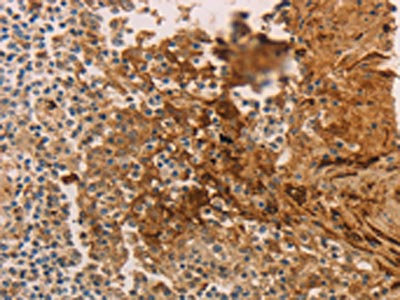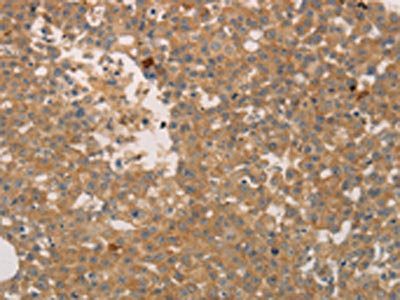ADCYAP1R1 Antibody
-
货号:CSB-PA207627
-
规格:¥1100
-
图片:
-
The image on the left is immunohistochemistry of paraffin-embedded Human tonsil tissue using CSB-PA207627(ADCYAP1R1 Antibody) at dilution 1/70, on the right is treated with synthetic peptide. (Original magnification: ×200)
-
The image on the left is immunohistochemistry of paraffin-embedded Human breast cancer tissue using CSB-PA207627(ADCYAP1R1 Antibody) at dilution 1/70, on the right is treated with synthetic peptide. (Original magnification: ×200)
-
Gel: 10%SDS-PAGE, Lysate: 40 μg, Lane 1-3: Hela cells, Mouse stomach tissue, Mouse brain tissue, Primary antibody: CSB-PA207627(ADCYAP1R1 Antibody) at dilution 1/2000, Secondary antibody: Goat anti rabbit IgG at 1/8000 dilution, Exposure time: 5 minutes
-
-
其他:
产品详情
-
Uniprot No.:P41586
-
基因名:
-
别名:ADCYAP1R1; Pituitary adenylate cyclase-activating polypeptide type I receptor; PACAP type I receptor; PACAP-R-1; PACAP-R1
-
宿主:Rabbit
-
反应种属:Human,Mouse
-
免疫原:Synthetic peptide of Human ADCYAP1R1
-
免疫原种属:Homo sapiens (Human)
-
标记方式:Non-conjugated
-
抗体亚型:IgG
-
纯化方式:Antigen affinity purification
-
浓度:It differs from different batches. Please contact us to confirm it.
-
保存缓冲液:-20°C, pH7.4 PBS, 0.05% NaN3, 40% Glycerol
-
产品提供形式:Liquid
-
应用范围:ELISA,WB,IHC
-
推荐稀释比:
Application Recommended Dilution ELISA 1:2000-1:10000 WB 1:1000-1:5000 IHC 1:50-1:200 -
Protocols:
-
储存条件:Upon receipt, store at -20°C or -80°C. Avoid repeated freeze.
-
货期:Basically, we can dispatch the products out in 1-3 working days after receiving your orders. Delivery time maybe differs from different purchasing way or location, please kindly consult your local distributors for specific delivery time.
相关产品
靶点详情
-
功能:This is a receptor for PACAP-27 and PACAP-38. The activity of this receptor is mediated by G proteins which activate adenylyl cyclase. May regulate the release of adrenocorticotropin, luteinizing hormone, growth hormone, prolactin, epinephrine, and catecholamine. May play a role in spermatogenesis and sperm motility. Causes smooth muscle relaxation and secretion in the gastrointestinal tract.
-
基因功能参考文献:
- These results show that b-arrestin1 and b-arrestin2 exert differential actions on PAC1R internalization and PAC1R-dependent ERK1/2 activation, and suggest that the two b-arrestin isoforms may be involved in fine and precise tuning of the PAC1R signaling pathways. PMID: 29734363
- Studies suggest that the level of stress and circulating gonadal hormones may differentially regulate the PACAPergic system in males and females to influence anxiety-like behavior and may be one mechanism underlying the discrepancies in human psychiatric disorders. [Review Article] PMID: 28610473
- These results provide evidence for an association between ADCYAP1R1 and PTSD and indicate that there may indeed be sex differences. PMID: 28746747
- These findings lead to a model in which E2 induces the expression of ADCYAP1R1 through binding of ERalpha at the ERE as an adaptive response to stress. Inhibition of E2/ERalpha binding to the ERE containing the rs2267735 risk allele results in reduced expression of ADCYAP1R1, diminishing estrogen regulation as an adaptive stress response and increasing risk for PTSD. PMID: 27959335
- Data suggest that GCGR (glucagon receptor) activation proceeds via a mechanism in which transmembrane helix 6 (TM6) is held in an inactive conformation by a conserved polar core and a hydrophobic lock (involving intracellular loop 3, IC3); mutations in the corresponding polar core of GCGR or PAC1R disrupt these inhibitory elements, allow TM6 to swing outward, and induce constitutive G protein signaling. PMID: 28356352
- Results confirmed for the first time that doxycycline specially targeted pituitary adenylate cyclase-activating polypeptide (PACAP) receptor type 1 (PAC1) imitating PACAP(30-37) and acted as an enhancer by facilitating the subsequent ligand binding and the activation of PAC1. PMID: 26700245
- Rsults suggest that impaired contextual conditioning in the hippocampal formation may mediate the association between type I receptor of the pituitary adenylate cyclase activating polypeptideand and posttraumatic stress disorder symptoms. PMID: 25680674
- Data show that glucocorticoid response genes NR3C1, ADCYAP1R1 and HSD11B2 were relatively hypomethylated whereas FKBP5 was hypermethylated. PMID: 26343289
- Further investigations of genetic factors for trauma-related psychopathology should include careful assessments of the social environment PMID: 26334183
- High child stress and an ADCYAP1R1 single-nucleotide polymorphism are associated with reduced bronchodilator response in children with asthma. PMID: 25918834
- and its receptor (PAC1) are involved in stress response and anxiety. PMID: 23972788
- association of variants with sudden infant death not supported PMID: 23981011
- PAC1/PACAP receptor endocytosis contributes to ERK acktivation. PMID: 24696141
- This review focuses on role of PAC1 receptor in brain development, behavior of transgenic animals and potential implication in human neurodevelopmental disorders. PMID: 24220567
- PAC1 receptor (ADCYAP1R1) genotype is associated with dark-enhanced startle in both male and female children. PMID: 22776899
- Individual differences in ADCYAP1R1 genotype may contribute to dysregulated fear circuitry known to play a central role in posttraumatic stress disorder and other anxiety disorders. PMID: 24516127
- Data indicate that VIP and PACAP increased macrophage resistance to HIV-1 replication by inducing the synthesis of beta-chemokines CCL3 and CCL5 and IL-10 following preferential activation of the receptors VPAC2 and PAC1. PMID: 23818986
- The findings suggest that the PACAP-PAC1 receptor pathway may play an important role in female human responses to traumatic stress PMID: 23394710
- ADCYAP1R1 genotype may have a role in post-traumatic stress symptoms in highly traumatized African-American females PMID: 23505260
- Genetic variation at the ADCYAP1R1 locus interacts with child abuse to shape risk of later posttraumatic stress disorder (PTSD) in women. PMID: 23280952
- Epigenetic and genetic variants in ADVYAP1R1 are associated with asthma in Puerto Rican children. PMID: 23328528
- [review] The Adcyap1r1 receptor single nucleotide polymorphism (SNP) is located within a predicted estrogen response element (ERE). PMID: 23147486
- Conclude that VPAC2/PAC1 receptors require NO in series to effect cutaneous active vasodilation during heat stress in humans. PMID: 22961270
- The increased expressions of PAC1 receptors on lactating breast may indicate a PACAP38/PAC1 interaction in the mammary gland during lactation. PMID: 22539193
- PAC1 regulates PYK-2 tyrosine phosphorylation in a calcium-dependent manner in lung cancer cell lines. PMID: 22581436
- Activation of Sp1 by the Ras/MAPK pathway might participate in neuron specific expression of the PAC1 gene. PMID: 22609358
- A reported association between rs2267735 and PTSD could not be replicated in either African American or European American females in two large independent samples. PMID: 21912390
- The present study constitutes the first characterization of the binding domains of PACAP to its specific receptor PAC1 and suggests heterogeneity within the binding mode of peptide ligands to class B GPCRs. PMID: 21185349
- VPAC2 and/or PAC1 receptor activation is involved in cutaneous active vasodilation in humans. PMID: 20395540
- Results indicate that VPAC1, but not VPAC2 or PAC1, up-regulation in macrophages is a common mechanism in response to acute and chronic pro-inflammatory stimuli. PMID: 20026142
- PACAP receptor type 1 mRNA is expressed in the trigeminal, otic and superior cervical ganglia (prejunctional) and cerebral arteries (postjunctional). PMID: 11930171
- HCT8 human colon tumor cells express PAC1, and PAC1 activation is coupled to adenylate cyclase, increase cytosolic [Ca(2+)](i), and cellular proliferation PMID: 12409223
- Using GST pull-down assay, ARF6 binds to the hop1 but not the null domain of PAC1 receptor PMID: 12409233
- receptors were positively coupled to adenylyl cyclase in human lung cancer, but the enzyme activity was impaired as compared to normal lung PMID: 12732341
- Expression of functional PAC(1), VPAC(1) and VPAC(2) receptors in human prostate as well as its maintenance after malignant transformation PMID: 12948842
- In colon cancer cell lines, PAC1 is expressed as the SV1 or HIP splice variant and is coupled to the activation only of cAMP but not of intracellular Ca2+. PMID: 14742913
- PAC(1)-R null variant is the most relevant isoform expressed in human prostaste cancer, and may be related with the events determining the outcome of prostate cancer. PMID: 16372333
- Stimulation of endogenously expressed PAC1 receptors with PACAP in human neuroblastoma cells increased APPsalpha secretion. PAC1R activation stimulates ERK phosphorylation. PMID: 16401644
- PAC1-R is the predominant PACAP receptor found in fetuses, and both PAC1-R and VPAC1-R are expressed in the mature cerebellum. PMID: 16572459
- Data demonstrate that altered neuronal proliferation/apoptosis and disrupted ependymal cilia are the main factors contributing to hydrocephalus in PAC1-overexpressing mice. PMID: 16823490
- PACAP may regulate the biological release of peptides and serotonin from BON cells PMID: 16888199
显示更多
收起更多
-
亚细胞定位:Cell membrane; Multi-pass membrane protein.
-
蛋白家族:G-protein coupled receptor 2 family
-
组织特异性:Most abundant in the brain, low expression in the lung, liver, thymus, spleen, pancreas and placenta.
-
数据库链接:
HGNC: 242
OMIM: 102981
KEGG: hsa:117
UniGene: Hs.377783
Most popular with customers
-
-
YWHAB Recombinant Monoclonal Antibody
Applications: ELISA, WB, IF, FC
Species Reactivity: Human, Mouse, Rat
-
Phospho-YAP1 (S127) Recombinant Monoclonal Antibody
Applications: ELISA, WB, IHC
Species Reactivity: Human
-
-
-
-
-























